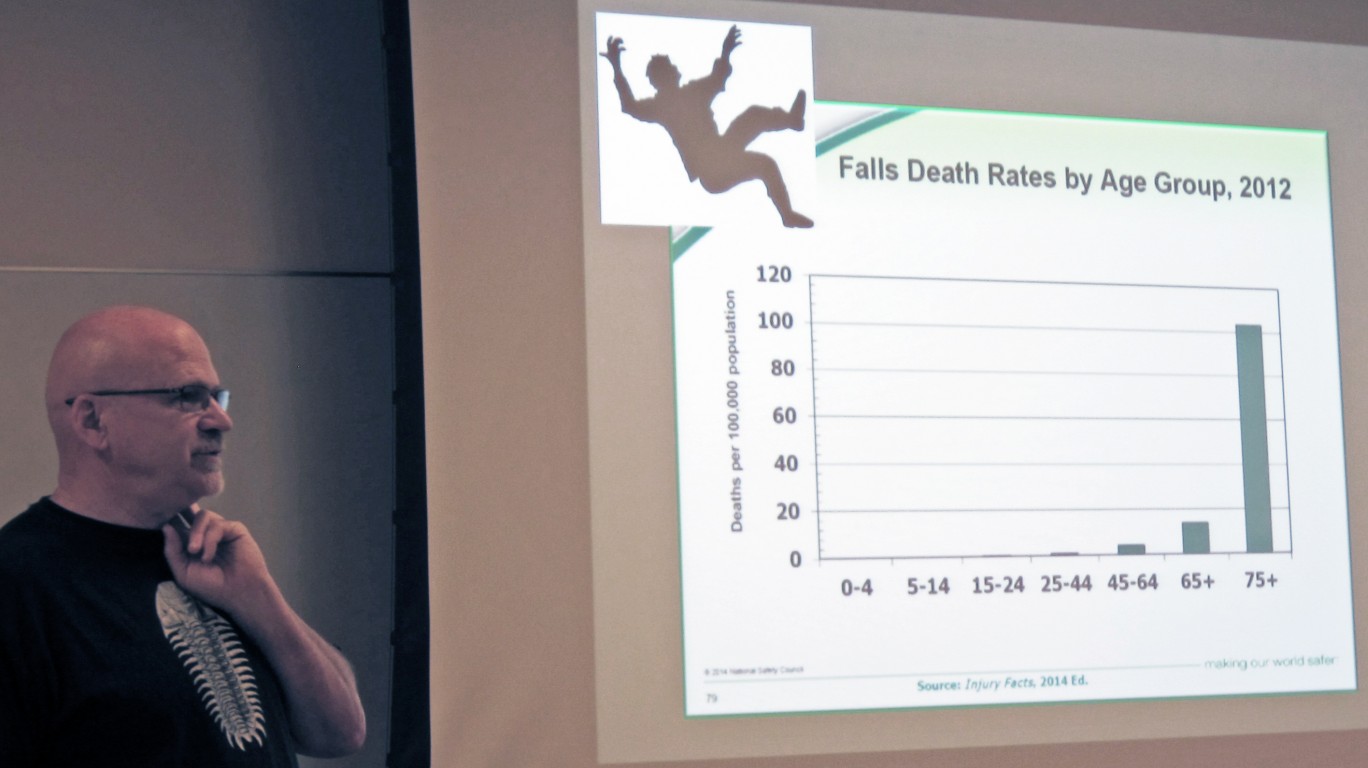
The U.S. economy is the largest and one of the most complex and dynamic in the world — and as a result, the only constant is change. Consumer preferences shift along with the demographic makeup of the country; production processes evolve along with technological advancements; and innovation gives way to all new kinds of products and merchandise.
In such an economic environment, the job market is constantly changing. Over the course of just 10 years, entire industries can take off, while others become decimated, shedding over half their workforce. Using data from the Bureau of Labor Statistics, 24/7 Wall St. reviewed employment change between 2009 and 2018 to identify America’s 25 dying industries.
It is no secret that certain technologies have come at the expense of hundreds of thousands of American jobs. Many different industries in the manufacturing sector have been gutted by automation. The proliferation of online media content has also led to the shuttering of newspapers and other print publications across the country. These and other similar industries rank among those on this list. Here is a look at how technology has changed the world since 2010.
The reduced need for most industries on this list has resulted not only in job cuts, but also led to slower wage growth. Across all industries, the average annual pay climbed by about 26% from 2009 to 2018. In the majority of the industries on this list, wage growth lagged behind the national average. Here is a look at the 25 lowest paying jobs in America.
Click here to see America’s 25 dying industries
Click here to see America’s 25 thriving industries
Click here to read our methodology
25. Land subdivision
> Employment change 2009-2018: -36.0%
> Employment total: 39,506
> 10-yr. change in avg. annual pay: +47.9%
> Avg. annual pay: $88,506
Over the past decade, overall employment in the land subdivision industry fell from nearly 62,000 to fewer than 40,000, one of the steepest declines in the U.S. labor market. The industry is primarily involved in dividing land into parcels for housing and other purposes.
[in-text-ad]

24. Air traffic control
> Employment change 2009-2018: -36.5%
> Employment total: 1,917
> 10-yr. change in avg. annual pay: +32.9%
> Avg. annual pay: $77,093
Air traffic controllers regulate the flow of air traffic. While the occupation will not likely disappear anytime soon, the amount of controllers is expected to continue to decline as improved technology allows one controller to handle more traffic.
23. Bituminous coal underground mining
> Employment change 2009-2018: -36.5%
> Employment total: 26,874
> 10-yr. change in avg. annual pay: +20.0%
> Avg. annual pay: $92,029
Coal production is falling in the United States. Between 2009 and 2018, underground coal mining production fell from 439.6 million short tons to 347.7 million. Over the same period, employment in bituminous underground coal underground mining fell from 42,341 to 26,874.
22. Photography studios, portrait
> Employment change 2009-2018: -37.0%
> Employment total: 40,833
> 10-yr. change in avg. annual pay: +27.0%
> Avg. annual pay: $27,433
Between 2009 and 2018, the number of people working in portrait photography studios fell by 37%. The industry is not the only one to have been gutted as a result of fairly recent digital photography advances and as the quality of digital cameras built into smartphones continues to improve.
[in-text-ad-2]
21. Telephone apparatus manufacturing
> Employment change 2009-2018: -37.3%
> Employment total: 17,946
> 10-yr. change in avg. annual pay: +33.1%
> Avg. annual pay: $132,330
The telephone apparatus manufacturing industry largely produces products like wire telephones, cordless phones, and answering machines â all products that have been made rather obsolete by the cell phone. In the United States, 96% of people have a cell phone of some kind.

20. Cable and other subscription programming
> Employment change 2009-2018: -37.8%
> Employment total: 53,533
> 10-yr. change in avg. annual pay: +63.3%
> Avg. annual pay: $125,495
The cable and other subscription programming industry includes businesses that operate television studios and subscription-based broadcasting facilities. Such companies include Comcast, Charter Communications, and Viacom. In the last decade, total employment in the industry fell by nearly 38%. The decline coincided with the growing popularity of streaming services like Netflix and Amazon Prime.
[in-text-ad]
19. Bituminous coal and lignite surface mining
> Employment change 2009-2018: -38.6%
> Employment total: 23,667
> 10-yr. change in avg. annual pay: +23.4%
> Avg. annual pay: $87,273
Coal production is falling in the United States. Between 2009 and 2018, surface coal mining production fell from 955.9 million short tons to 672.8 million. Over the same period, employment in bituminous coal and lignite surface mining fell from 38,530 to 23,667.
18. Support activities for coal mining
> Employment change 2009-2018: -39.3%
> Employment total: 4,830
> 10-yr. change in avg. annual pay: +22.5%
> Avg. annual pay: $76,053
Coal production is falling in the United States. Between 2009 and 2018, total coal production fell from 1.4 billion short tons to 1.0 billion. Over the same period, employment in the support activities for coal mining industry fell from 7,963 to 4,830.

17. Citrus, except orange, groves
> Employment change 2009-2018: -39.4%
> Employment total: 2,315
> 10-yr. change in avg. annual pay: +31.9%
> Avg. annual pay: $32,156
This industry includes establishments that grow a wide variety of citrus fruits, including lemons, tangerines, mandarins, and grapefruits. The nearly 40% employment decline in the industry over the last 10 years is likely attributable in part to increased efficiency in large scale crop production that has reduced the need for personnel and led to the consolidation of farms.
[in-text-ad-2]

16. Savings institutions
> Employment change 2009-2018: -41.2%
> Employment total: 112,066
> 10-yr. change in avg. annual pay: +33.2%
> Avg. annual pay: $70,794
This industry, which largely comprises savings and loan associations and savings banks, is one of only 16 in the United States to have shed over 40% of its workforce in the last 10 years.

15. Bookstores
> Employment change 2009-2018: -41.3%
> Employment total: 71,299
> 10-yr. change in avg. annual pay: +14.2%
> Avg. annual pay: $19,827
Between 2009 and 2018, the number of bookstores in the United States fell by a third — from nearly 10,000 to fewer than 6,500. Over the same period, employment in the industry was slashed by 41.3%. Much of the decline is attributable to the growth of e-books. The digitization of books contributed to the bankruptcy of the Borders bookstore chain, which liquidated its assets in 2011, laying off some 11,000 workers and closing 400 locations.
[in-text-ad]

14. Junior colleges
> Employment change 2009-2018: -42.7%
> Employment total: 26,100
> 10-yr. change in avg. annual pay: +8.2%
> Avg. annual pay: $41,695
Junior colleges are educational institutions that issue degrees below the baccalaureate level, including associate degrees and technical certifications. In the last decade, the number of people working in the industry declined by 42.7%. The decline in employment in private junior colleges is in stark contrast to the projected surge in overall employment in postsecondary institutions in the next decade. The decline in junior colleges is likely due in part to the decline of private, for profit colleges.
13. Newspaper publishers
> Employment change 2009-2018: -46.9%
> Employment total: 146,505
> 10-yr. change in avg. annual pay: +23.0%
> Avg. annual pay: $52,813
Few industries have been hit as hard as newspaper publishing in the United States in recent years, mostly due to internet use growth. As online news content has proliferated, and is now accessible through smartphones, newspaper subscriptions have fallen precipitously. In 2009, there were an estimated 45.7 million weekday newspaper subscriptions. As of 2018, there were only about 28.6 million.

12. Photographic film and chemical manufacturing
> Employment change 2009-2018: -47.2%
> Employment total: 10,251
> 10-yr. change in avg. annual pay: +10.1%
> Avg. annual pay: $65,865
Advances in digital photography and improved smartphone cameras have spelled doom for the traditional film photography industry. Between 2009 and 2019, the number of Americans working in the photographic film and chemical manufacturing industry was nearly halved, falling from 19,427 to just over 10,000.
[in-text-ad-2]

11. Photofinishing laboratories, except one-hour
> Employment change 2009-2018: -47.4%
> Employment total: 7,874
> 10-yr. change in avg. annual pay: +63.1%
> Avg. annual pay: $60,682
Along with other industries on this list, like portrait photography and film manufacturing, photofinishing laboratories are being gutted as digital and smartphone camera technology continues to improve. In the last 10 years, the number of establishments providing such services fell by 38.8%, and employment fell by an even more staggering 47.4%.

10. Newsprint mills
> Employment change 2009-2018: -48.6%
> Employment total: 4,255
> 10-yr. change in avg. annual pay: +20.5%
> Avg. annual pay: $88,229
Few industries have been hit as hard as newspaper publishing in the United States in recent years. In 2009, there were an estimated 45.7 million weekday newspaper subscriptions. As of 2018, there were only about 28.6 million. This has led to reduced demand for newsprint manufacturing, and in the last decade employment in newsprint mills has been nearly cut in half.
[in-text-ad]

9. Telecommunications resellers
> Employment change 2009-2018: -50.1%
> Employment total: 50,599
> 10-yr. change in avg. annual pay: +20.1%
> Avg. annual pay: $83,393
The telecommunications reseller industry is one of only nine in the United States to have shed over half of its workforce in the last 10 years. The industry’s primary function is to purchase access and network capacity from telecom companies and then sell communication services to households and companies.

8. Private households
> Employment change 2009-2018: -52.9%
> Employment total: 292,491
> 10-yr. change in avg. annual pay: +56.4%
> Avg. annual pay: $26,395
The private household industry consists of those working in homes in roles such as nannies, maids, cooks, butlers, and gardeners. There were only 292,491 people working in the industry in 2018, less than half the 675,921 figure in 2009.
7. Greeting card publishers
> Employment change 2009-2018: -53.9%
> Employment total: 4,363
> 10-yr. change in avg. annual pay: +13.1%
> Avg. annual pay: $64,344
Greeting card publishing is far less of a viable employment option today than it was a decade ago. Between 2009 and 2018, the number of people working in greeting card publishing fell from about 9,500 to fewer than 4,500.
[in-text-ad-2]
6. Directory and mailing list publishers
> Employment change 2009-2018: -55.4%
> Employment total: 17,372
> 10-yr. change in avg. annual pay: +20.1%
> Avg. annual pay: $76,229
Directory and mailing list publishers, who publish phone books, mailing lists, and other directories, are becoming far less common in the United States, as more and more information can be accessed online. Overall employment fell by 55.4% in the industry in the last decade and now stands at just over 17,000.

5. Uranium-radium-vanadium ore mining
> Employment change 2009-2018: -63.3%
> Employment total: 334
> 10-yr. change in avg. annual pay: +59.1%
> Avg. annual pay: $107,479
There are far fewer people working to mine uranium, radium, and vanadium ore mining now than there were a decade ago. Between 2009 and 2018, overall employment in the industry fell by 63.3%.
[in-text-ad]

4. Business and secretarial schools
> Employment change 2009-2018: -68.3%
> Employment total: 4,909
> 10-yr. change in avg. annual pay: +24.6%
> Avg. annual pay: $43,647
This industry consists of private institutions that primarily teach somewhat outdated office procedures and secretarial skills, such as word processing. In the last decade, employment in such establishments fell by over two-thirds.

3. Port and harbor operations
> Employment change 2009-2018: -70.1%
> Employment total: 6,110
> 10-yr. change in avg. annual pay: +2.1%
> Avg. annual pay: $70,773
Employment in port and harbor operations has fallen by over 70% in the last decade, more than in all but two other industries. The decline is likely attributable in part to increased automation and larger vessels that can carry more cargo and require fewer workers.
2. One-hour photofinishing
> Employment change 2009-2018: -74.9%
> Employment total: 547
> 10-yr. change in avg. annual pay: +28.3%
> Avg. annual pay: $29,837
Photofinishing laboratories are shuttering operations as digital and smartphone camera technology continues to improve. The number of people working in the once ubiquitous one-hour photofinishing establishments fell by nearly 75%. Over the same period, the number of businesses offering one-hour photo development declined by 66.4%.
[in-text-ad-2]

1. Hydroelectric power generation
> Employment change 2009-2018: -82.7%
> Employment total: 6,538
> 10-yr. change in avg. annual pay: +29.9%
> Avg. annual pay: $121,336
The electricity grid in the United States is becoming less and less dependent on hydroelectricity. In the middle of the 20th century, about 30% of the electricity generated nationwide came from hydraulic sources. Today, hydroelectricity accounts for only about 7% of the energy mix. Still, recent declines in employment in the industry are more attributable to technological advances that reduce the need for personnel than declining demand.
Methodology
To identify America’s 25 dying industries, 24/7 Wall St. reviewed employment change from 2009 through 2018 for U.S. industries in the fourth level of detail in the North American Industry Classification System by the Office of Management and Budget. All data, including the number of establishments within each industry and average weekly and annual wages, was retrieved from the U.S. Bureau of Labor Statistics’ Quarterly Census of Employment and Wages.
The BLS tracks industry employment by tallying the number of workers in establishments whose primary sources of revenue fall within a given industry. As a result, a given establishment along with all of its employees may be reclassified depending on business decisions and market performance. To help ensure that the 10-year employment changes reflect natural growth, we excluded all industries related to the management of funds, trusts, and other financial vehicles because classification in that industry may change frequently depending on investment decisions.
Is Your Money Earning the Best Possible Rate? (Sponsor)
Let’s face it: If your money is just sitting in a checking account, you’re losing value every single day. With most checking accounts offering little to no interest, the cash you worked so hard to save is gradually being eroded by inflation.
However, by moving that money into a high-yield savings account, you can put your cash to work, growing steadily with little to no effort on your part. In just a few clicks, you can set up a high-yield savings account and start earning interest immediately.
There are plenty of reputable banks and online platforms that offer competitive rates, and many of them come with zero fees and no minimum balance requirements. Click here to see if you’re earning the best possible rate on your money!
Thank you for reading! Have some feedback for us?
Contact the 24/7 Wall St. editorial team.

 24/7 Wall St.
24/7 Wall St.



 24/7 Wall St.
24/7 Wall St.

 24/7 Wall St.
24/7 Wall St.



